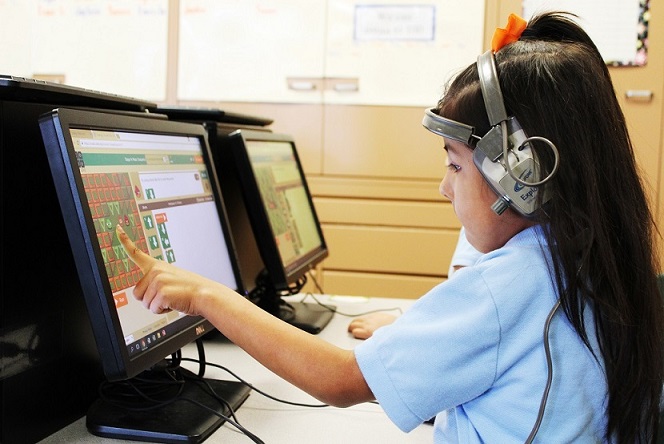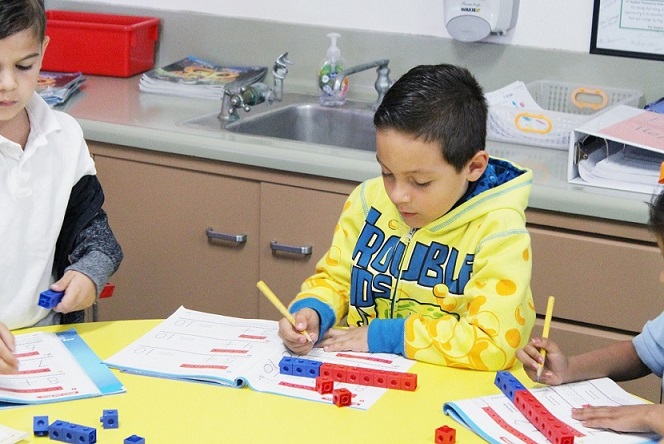Bassett Unified School District
Bassett Unified Launches Pilot Elementary School Computer Science Program
LA PUENTE, CA – Five-year-old Isaac Flores, a Sunkist Elementary School kindergartener, pressed a green “GO” button on a yellow bee robot (Beebot) and watched with classmates as it navigated a paper maze based on step-by-step commands each student programmed into the bot.
Sunkist transitional kindergarteners, kindergarteners and first- through fifth-graders are taking their first steps in creating algorithms and writing code through pilot computer science courses.
“Forward, forward, pause, forward…” the group of students said together, as the Beebot moved to specific points on the maze from its beehive to the end goal: a honeycomb. The bot beeped and flashed twice, signifying the end of its journey, as the students cheered their successful programming.
“I like to control Beebot to get it to do what I want it to do,” Isaac said. “I learn a lot with Beebot.”
The coding curriculum teaches elementary school students computer science concepts and terms through interactive programs. This year, all grade levels offer an introductory course teaching the importance of code sequence and building critical thinking skills.
“My students love coding and no longer want to use the words ‘giving directions’ – they want me to say I am giving them algorithms,” kindergarten teacher Arin McDonald said. “All of the students are engaged and trying hard to complete each puzzle.”
Bassett Unified School District teacher specialist Michael Jephcott introduced Sunkist to the curriculum through nonprofit Code.org, which provides computer science curriculum for kindergarten through grade 12. Jephcott researched grade-appropriate materials, such as Beebot, to integrate with the lessons.
“Students can build a strong foundation in computer science courses if they start learning concepts at a young age,” Jephcott said. “They will build their critical thinking, math and language arts skills by learning the skills needed for computer programming.”
Sunkist Principal Alejandra Pantoja and 22 teachers attended a seven-hour workshop with Code.org to prepare the pilot program. Jephcott, who specializes in technology integration in the classroom, and other Bassett Unified teacher specialists will continue to provide training once a month.
Coding classes are offered in the school’s computer lab or through iPad carts in the classroom. Students can learn with partners, with one person giving instructions while the other writes the code.
“Bassett Unified is focused on providing our students with opportunities to learn computer science concepts at an early age, which will give them an extra boost in building a strong foundation of skills needed in college and the workforce,” Superintendent Dr. Alex Rojas said. “Sunkist’s pilot program makes coding fun and drives our students’ interest in the subject.”
PHOTOS:
112916_BASSETTUSD_CODING1: A Sunkist Elementary School kindergartener counts how many spaces she needs to program a character to move to its destination, as part of a pilot programming course launched this year.
112916_BASSETTUSD_CODING2: A group of Sunkist Elementary School kindergartners strengthen math concepts through hands-on activities that help with early coding comprehension.


Bassett Unified Launches Pilot Elementary School Computer Science Program
Bassett Unified School District
- Image Title
- 112916_bassettusd_coding1
- Image Caption
- 112916_BASSETTUSD_CODING1: A Sunkist Elementary School kindergartener counts how many spaces she needs to program a character to move to its destination, as part of a pilot programming course launched this year.
Right-click on the image to save
- Image Title
- 112916_bassettusd_coding2
- Image Caption
- 112916_BASSETTUSD_CODING2: A group of Sunkist Elementary School kindergartners strengthen math concepts through hands-on activities that help with early coding comprehension.
Right-click on the image to save


